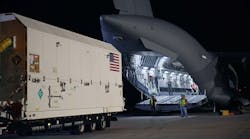Global Positioning System (GPS) technology has become such a part of daily life, for civilian as well as military users, that next-generation GPS satellites are being built to be more accurate and harder to jam than ever before. In fact, Lockheed Martin is clearing the way for the use of third-generation GPS satellites. On August 20, the company shipped the first of the U.S. Air Force’s GPS III space vehicles (GPS III SV01) to Cape Canaveral, Fla. for its expected launch in December of this year. This third-generation GPS satellite will provide the most powerful version of the positioning system technology ever placed into orbit.
The GPS satellite was designed at built at Lockheed Martin’s GPS III Processing Facility near Denver, Colo. The satellite was shipped from Buckley Air Force Base, Colo. to the Cape Canaveral on an Air Force C-17 aircraft. The satellite features a new design, with three times greater accuracy than earlier versions of GPS satellites and eight times improved anti-jamming capabilities compared to earlier, second-generation GPS II satellites (which form the current constellation of GPS satellites).
The GPS III satellite will also be the first space vehicle to broadcast the new L1C civilian signals. The L1C signals, which are shared by other international global navigation satellite systems such as Galileo, is expected to improve connectivity for commercial and civilian users.
“Once on orbit, the advanced technology of this first GPS III space vehicle will begin playing a major role in the Air Force’s plan to modernize the GPS satellite constellation,” said Johnathon Caldwell, Lockheed Martin’s program manager for Navigation Systems. “We are excited to start bringing GPS III’s new capabilities to the world and proud to continue to serve as a valued partner for the Air Force’s positioning, navigation, and timing mission systems.” This GPS III space vehicle is the first of 10 new GPS III satellites under contract and in full production at Lockheed Martin.

